

Perth Fork Trucks - Safety, Strenght & Expert Advice — Pallet Trolleys, Fork Lifts, Container Handlers and Reach Stackers in Western Australia. How to Work a Forklift. HowStuffWorks "How Forklifts Work" Most of us probably have a general idea of what a forklift is, but there are a number of different classifications, power sources, sizes, uses and new technologies that make up these useful machines.
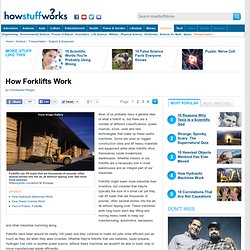
Some are used on rugged construction sites and lift heavy materials and equipment while other forklifts drive themselves inside modernized warehouses. Whether indoors or out, forklifts are a necessary tool in most warehouses and an integral part of our industries. Forklifts might seem more industrial than inventive, but consider that they're typically the size of a small car yet they can lift loads that are thousands of pounds, often several stories into the air, all without tipping over. These machines work long hours each day lifting and moving heavy loads to keep our manufacturing, automotive, aerospace and other industries humming along. Forklifts have been around for nearly 100 years and they continue to make our jobs more efficient just as much as they did when they were invented. How to Drive a Forklift: 9 Steps. Edit Article Edited by Wingrider, IngeborgK, Jfisher446, Tryme2 and 5 others If you have never driven a forklift before, this will certainly help!
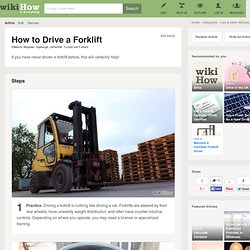
Ad Steps 1Practice. 9Practice driving the forklift in an open area. Tips Drive safely and follow all safety precautions given in the drivers manual.Use your common sense to determine at what height the weight is balanced. Warnings Park the forklift with the fork completely on the ground when you are finished.Do not operate a forklift in an area of heavy foot or vehicular traffic, nor in slippery or otherwise unsafe working conditions. Types of Forklifts. Forklifts are like mini-trucks that are used for lifting and transferring heavy loads.
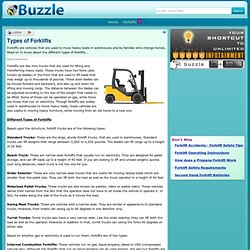
These trucks have two forks (also known as blades) in the front that are used to lift loads that may weigh up to thousands of pounds. These steel blades can be moved forward and backward, and also up and down for lifting and moving cargo. The distance between the blades can be adjusted according to the size of the weight that needs to be lifted. Some of these can be operated on gas, while there are those that run on electricity. Though forklifts are widely used in warehouses to move heavy loads, these vehicles are also useful in moving heavy furniture, while moving from an old home to a new one. Different Types of Forklifts Based upon the structure, forklift trucks are of the following types: Standard Trucks: These are the large, sturdy forklift trucks, that are used in warehouses.
Reach Truck: These are narrow-aisle forklifts that usually run on electricity. How to Maintain a Forklift: 5 Steps. Edit Article Edited by ForkliftU, Mark Davis Forklifts are the ideal equipment for moving heavy loads in an industrial setting.
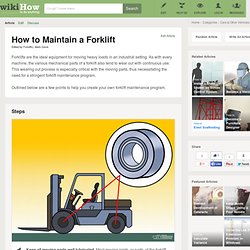
As with every machine, the various mechanical parts of a forklift also tend to wear out with continuous use. This wearing out process is especially critical with the moving parts, thus necessitating the need for a stringent forklift maintenance program. Outlined below are a few points to help you create your own forklift maintenance program. Ad Steps 1Keep all moving parts well lubricated. 5Keep Forklift Tires in Good Shape. Tips. The Classifications of Forklift Trucks. The forklift truck has been around for a little under a century, but today it is found in every warehouse operation around the world.
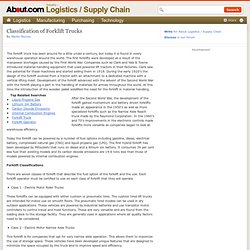
The first forklifts were developed as a result of the manpower shortages caused by the First World War. Companies such as Clark and Yale & Towne introduced material handling equipment that used powered lift tractors in their factories. Clark saw the potential for these machines and started selling them in 1918. During the early 1920's the design of the forklift evolved from a tractor with an attachment to a dedicated machine with a vertical lifting mast. Development of the forklift advanced with the advent of the Second World War with the forklift playing a part in the handling of materials for armies throughout the world. Today the forklift can be powered by a number of fuel options including gasoline, diesel, electrical battery, compressed natural gas (CNG) and liquid propane gas (LPG). How to Transport a Forklift.